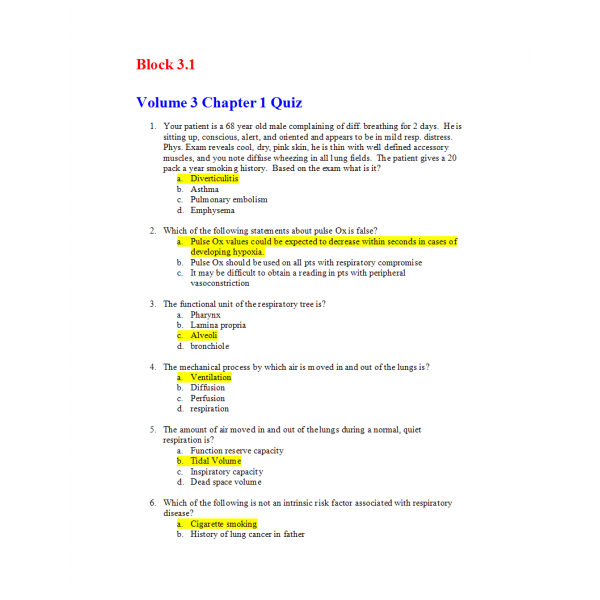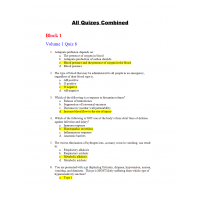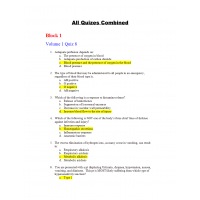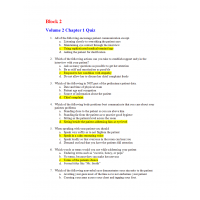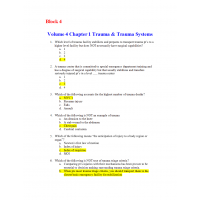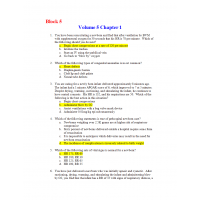PAR 100 San Diego Miramar College Vol 3
PAR 100 Volume 3 Chapter 1 Quiz
1. Your patient is a 68 year old male complaining of diff. breathing for 2 days. He is sitting up, conscious, alert, and oriented and appears to be in mild resp. distress. Phys. Exam reveals cool, dry, pink skin, he is thin with well defined accessory muscles, and you note diffuse wheezing in all lung fields. The patient gives a 20 pack a year smoking history. Based on the exam what is it?
2. Which of the following statements about pulse Ox is false?
3. The functional unit of the respiratory tree is?
4. The mechanical process by which air is moved in and out of the lungs is?
5. The amount of air moved in and out of the lungs during a normal, quiet respiration is?
6. Which of the following is not an intrinsic risk factor associated with respiratory disease?
7. The most superior portion of the pharynx is the?
8. The structure that occludes the trachea to prevent aspiration during swallowing is the?
9. Lung perfusion depends on all of he following except:
10. Diffusion is defined as:
11. Your patient is a 24 year old male experiencing an acute onset of SOB. Expiratory wheezes are auscultated in all lung fields. Your primary goal in managing this patient is to?
12. Your patient is a 72 year old female, alert and oriented, sitting up in bed at a nursing home. She is in mild resp. distress. Staff describes a 4 day history of fever, malaise, and productive cough. The patient also states that she has been experiencing chills and chest pain with deep inspiration. Physical exam. Reveals rhales and rhonchi in the right upper lobes and warm, moist skin. Based on the clinical exam findings, the most appropriate diagnosis would be?
13. Which of the following best defines perfusion?
14. All of the following are acceptable methods of clearing a FBAO in an unconscious supine adult except:
15. A hyperresponsive airway is likely to be in all the following conditions except:
16. Improving ______ is a primary treatment goal in a pt with bronchospasm.
17. Which of the following would result in an increased respiratory rate?
18. Normal inspiration involuves all the following except
19. The carpopedal spasm that occur due to the hyperventilation syndrome are a result of realitive _______, secondary to _________.
20. Which of the following statements comparing asthma and emphysema is TRUE:
21. Management of a pt who is hyperventilating should include:
22. An example of diffusion in the respiratory system is
23. Which of the following statements about capnography is false
24. A 61 yr old male with a 24 pack a year history of cigarette smoking presents with pursed lips, SOB. You note that he is thin and has florid skin and a barrel chest. Auscultation of his lungs reveals diffuse expiratory wheezing in all fields. Based on this clinical condition, what additional complication is most likely to develop.
25. Your pt is a 16 yr old male who attempted suicide. He is unconscious and apneic, lying supine on his garage floor. The pt was found in the front seat of a running car. HR 70, BP 100/60, RR 0, in addition to IV with NS, which of the following is most approp
26. Which of the following is the purpose of surfactant in the lungs
27. Your pt is a 68 yr old male complaining of difficulty breathing for 2 days. He is sitting up alert, and orientated and appears to be in mild respiratory distress. Skins are cool, dry, and pink and he appears thin with well defined accessory muscle use. You hear wheezing in all lung fields. HR 102, BP 136/96, RR 20, SaO2 92%. The pt gives a 20 pack a year history of smoking. Based on these findings, which of the following is most likely.
28. During inspiration the air pressure in the chest cavity is _____ than atmospheric pressure.
29. Which of the following is not a role of the upper respiratory system
30. Your pt is a 23 yr old male in severe respiratory distress. The pt was working in a small enclosed space when he split a 5 gallon drum of ammonia onto the floor and was quickly overcame by fumes. A coworker has pulled him from the room to safety and assured no ammonia has spilled onto his clothing. The pt is complaining of burning sensation to his throat and lungs, and you note his voice is becoming progressively more horse. Lung sounds revel crackling and wheezing in all lung fields. HR 144, BP 150/100, RR 30, SaO2 90%. In addition to IV with NS at TKO rate, which of the following is the best course of action
31. Your pt is a 34 yr old male complaining of SOB. He gives a 3 day history of runny nose, sore throat, and nonproductive cough. His SOB began after a long bout of hard coughing. His skin is cool, dry, and slightly pale. Lung sounds are clear and equal bilaterally. HR 102, BP 136/90, SaO2 95%. Which of the following is the best course of action?
32. The _______ plura lines the thoracic cavity and contains nerve fibers
33. An increased hydrogen ion concentration in the cerebrospinal fluid results in a(n) _______ respiratory rate
34. Normal exhalation requires all the following except:
35. Impulses from the ______ nerve(s), which originate in the ________, stimulate the diaphragm to contract
36. An increase in arterial PCO2 results in a(n)_______ in cerebrospinal fluid pH and a(n)_________ in ventilation
37. You have intubated a 66yr old female pt who was experiencing an acute exacerbation of her emphysema. What special consideration does this pt, with her specific pathology require
38. Which of the following is the most important determination of ventiatory rate
39. Which of the following correctly lists the divisions of the bronchial tree in descending order:
40. ______ risk factors are those that are influenced by or are from within the patient.
41. The anatomical difference between the two mainstem bronchi helps to explain why:
42. The alveoli are moistened and kept open because of the presence of an important chemical called _______ that is secreted by type II cells found on the alveolar surface.
43. Nerve impulses from the ________ nerve, which begins in the region of the cervical portion of the spinal cord and travels through the chest cavity, stimulate the diaphragm to contract.
44. The total volume of air in the lungs, called the _______ measures approximately 6K in an adult male.
45. The most important determinant of the ventilatory rate is the arterial _____
46. The oxygen dissociation curve can be altered by changes in the:
47. Cellular respiration occurs in the peripheral:
48. ________ is (are) characterized by long, deep breaths that are stopped during the inspiratory phase and separated by periods of apnea; this pattern is a result of stroke or sever central nervous system disease.
49. Common medications used by patients with COPD include all of the following except:
50. A whistling sound due to narrowing of the airways by edema, bronchoconstriction, or foreign materials describes:
51. The preferred abbreviation to describe oxygen saturation measurement is ________.
52. _________ is a graphic recording or display of the capnometry reading over time.
53. _______ describes an excess of red blood cells resulting in an abnormally high hematocrit.
54. The paramedic should measure _________ to determine the severity of an asthma attack and the degree of response to treatment
55. Your pt is a 30 year old male who has been in pt in a rehabilitation hospital following surgical reduction of a fractured pelvis. Staff reports sudden development of hypotension and severe respiratory distress about thirty minutes ago. There is no other significant history. Physical exam findings include cold, diaphoretic skin with peripheral cyanosis; jugular venous distention; clear breath sounds bilaterally; and vitals as follows: HR 134, BP 74/50, RR 28, SaO2 84%. Which of the following is most likey?
56. Your pt is a tall, thin, 34 yr old male complaining of shortness of breath. He gives a three day history of runny nose, sore throat, and a nonproductive cough. His shortness of breath began after a long bout of hard coughing. His skin is cool, dry, and slightly pale. Lung sounds are clear and equal bilaterally. HR 102, BP 136/90, RR 16, SaO2 = 95. Which of the following is the most appropriate course of action?
Volume 3 Chapter 2a Test
1. The presence of inverted T waves on an ECG indicates:
2. Pharmacological interventions initiated by prehospital care providers in the treatment of CHF include all of the following except:
3. Which of the following best characterizes successful defibrillation?
4. An elevation of the ST segment is associated with:
5. Management for a patient experiencing angina may include all of the following except:
6. Which of the following is not a likely immediate cause of acute myocardial infarction:
7. Which of the following ECG findings may occur with unstable angina:
8. The most common cause of death resulting from MI is:
9. Your patient is a 38 year old male who was involved in a motor vehicle accident in which he sustained blunt force trauma to his chest. Physical exam reveals JVD, difficulty breathing, equal lung sounds bilaterally, and a narrowing pulse pressure. Which of the following is most likely:
10. A 42 yo female is alert and oriented, complaining of chest pain. Which of the following questions would be the least productive with regard to performing a focused history:
11. Which of the following is most characteristic of right heart failure:
12. The heart sound produced by closure of the AV valve is:
13. Which of the following is not indicated for a 44 year old male who is supine on the floor, pulseless, and apneic after experiencing chest pain and shortness of breath:
14. A 63 year old male is alert and oriented, complaining of dizziness. He describes an acute onset of dizziness and near syncope that has lasted for 15 minutes. He is also experiencing substernal chest pain radiating to his jaw, as well as nausea, and weakness. Physical exam reveals cool, diaphoretic skin, delayed cap refill and mild rales to the bases bilaterally. He has no significant med. History, but he takes 325 mg of aspirin a day. Hr=220, BP=88/52, RR=16, SaO2=95%. The patient is receiving O2 by NRB. Which of the following should be done first:
15. Which of the following is least likely to be associated with an AMI:
16. ________ is a drop in systolic B/P of more than 10mmHg with inspiration.
17. Paramedics use all of the following interventions to treat CHF Except:
18. Your pt’s ECG shows a braid S wave in lead 1, and an R-S-R prime complex in lead V1. this indicates a:
19. The predominant effect of a drug with primarily alpha properties would result in which of the following:
20. Cardioversion is used to treat all of the following rhythms except:
21. Signs and symptoms of decreased tissue perfusion secondary to cardiogenic shock include all of the following except:
22. A 67 year old male is unconscious, sitting in a chair, and has agonal respirations. His wife states that he was up all night with difficulty breathing and chest discomfort but would not go to the hospital. Physical exam reveals pink, frothy sputum in the airway; cold, diaphoretic skin; and rales audible without a steth. HR=108, BP-=74/P, RR=4, SaO2=82%. The monitor shows sinus tach. Which of the following is the highest priority when treating this patient?
23. The heart sound produced by the closing of the aortic and pulmonary valves is:
24. A 48 year old male is sitting upright in bed in resp. distress. He describes an acute onset of difficulty breathing and C/P during the night that has been worsening for the past 3 hours. He also complains of nausea. Pain is described as a substernal pressure radiating to his left shoulder. Physical exam reveals cool, diaphoretic skin; and rales on auscultation bilaterally. Med. History includes two prior MI. Meds. Include Zestril and metaprolol. HR=132, BP=140/100, RR=25, SaO2=92%. Which of the following is not indicated:
25. A 66 year old male is supine on the waiting room floor in a dentist office. He is pulseless and apneic. Bystanders state he seemed excessively anxious and then collapsed about 5 minutes ago. The monitor shows asystole in the three leads. Which of the following is the most appropriate first action:
26. A 45 year old male is alert and oriented, complaining of chest pain. He describes a 2 day history of worsening pain described as a burning sensation below his left breast that radiates across his chest. He states that the pain seems to get better right after eating, but then worsens again. Medical history includes MI, hypertension, and type two diabetes. His meds include Inderal, Vasotech, glucotrol, and lopid. Physical exam reveals cool, dry skin; clear lungs, and no JVD or peripheral edema. HR=102, BP=132/86, RR=12, SaO2=98%. The patient is on O2 by cannula at 4 lpm. Which of the following should be done next?
27. Which of the following is not a likely immediate cause of AMI?
28. A decrease in preload results in a:
29. Which of the following best differentiates cardioversion from defibrillation:
30. A 48 yr old male complaining of chest pain that he describes as dull, located substernally, but radiating to his neck. He rates the pain as six and complains of nausea and lightheadedness. His skin is cool and diaphoretic. HR=96, BP=124/82, RR=14, SaO2=97% The 12 lead is nondiagnostic, In addition to O2, NS at TKO, and transport, which of the following would be most appropriate
31. Your pt is a 54 yr old male who is unresponsive and cyanotic with aganol respirations. A quick look down shows V-tach. Which of the following is most important when determining the immediate treatment of this pt?
32. Parasympathetic innervation of the heart occurs with the ______
33. A 56 yr old male is alert and orientated and complaining of severe, tearing, pain in his abdomen that radiates to his back, as well as numbness in his legs. He has a hx of hypertension, and type II diabetes. His skins are cool and diaphoretic. HR=110, BP=108/82, RR=20, SaO2=98%, which of the following does the pt need most right now
34. Which of the following best describes the physiology of anastomosis:
35. The appearance of a pathological Q wave on a ECG indicates the presence of ______ tissue.
36. Measures to treat Cardiogenic shock include all of the following except:
37. Which of the following would you expect NOT to find while assessing a pt with cardiac tamponade
38. The hearts normal electrical axis has a range of ____ to ____
39. Two examples of a fibrinolytic are
40. The muscle in a typical artery falls in between what layers
Volume 3 Chapter 2b
1. The hearts electrical axis is 59 degrees. In normal tracing which lead will have the most positive deflection?
2. The thick middle tissue layer of the heart is the?
3. An elevation of the ST segment is associated with?
4. The passage of the electrical current away from the positive will cause _______deflection on the recorder?
5. Any time the axis equals or exceeds +105 degrees the patient is said to have?
6. Two electrodes of opposite polarity are utilized they are called?
6. Leads 1, 2, 3 are?
7. The very outmost layer of a typical artery is called the what
8. Myocardial ischemia results in?
9. This coronary artery provides oxygen to the cardiac cells at the SA node
10. The precardial leads provide a view of the?
11. Your pt has a hx of progressively worsening angina that comes on at rest. This most indicates ______ angina
12. The pressure in the left ventricle at the end of diastole is called
13. The amount of resistance that must be overcome by the left ventricle during systole is called ______.
14. Cardioversion is used to treat all the following rhythms except:
15. Action potential begins in a myocardial cell when:
16. The relative refractory period of the myocardium is represented by the ______.
17. Signs and or symptoms of a dissecting aortic aneurysm include all of the following except:
18. The lead to the left of the sternum at the forth intercostal space is the
19. Your pt’s ECG shows a braid S wave in lead 1, and a R-S-R complex in lead V1, This indicates a:
20. Which of the following ECG findings is LEAST anticipated in a pt experiencing an acute myocardial infarction?
21. An infarction that affects only the deeper levels of the myocardium is a(n):
22. Myocardial ischemia results in:
23. Parasympathetic innervation of the heart occurs via the _______?
24. Your pt is in a-fib, has a heart rate of 108 on the monitor, but her radial pulse is 8
25. Increased _______ does NOT occur due to increased venus return to the heart
26. The left coronary artery supplies blood to all these areas except:
27. _______ is a first line antidysrhythmic used to treat and prevent life threatening ventricular dysrhythmias.
28. ______ ______ states that the more the myocardial muscle is stretched, the greater its force of contraction will be
29. The period of time when the myocardium is relaxed and cardiac filling and coronary perfusion occur is called:
30. A positive dromotropic agent will
31. A pt with stable atrial tachycardia would be given which drug
32. Certain chemicals that are released by the heart when myocardial cells are damaged are called.
Volume 3 Chapter 2-C
1) The hearts electrical axis is 59 degrees. In normal trasing which lead will have the most positive deflection?
2) The thick middle tissue layer of the heart is the?
3) An elevation of the ST segment is associated with?
4) Passage of the electrical current away from the positive will cause deflection on the recorder?
5) The dysrhythmia characterized by each impulse arriving at the AV junction being progressively delayed until, eventually, AV conduction is completely blocked is called ______ AV block (Mobitz 1)
6) Any time the axis equals or exceeds +105 degrees the patient is said to have?
7) Two electrodes of opposite polarity are utilized they are called?
8) Leads 1, 2, 3 are?
9) Myocardial ischemia results in?
10) In lead 2, the negative electrode is placed on the?
11) Which of the following ECG findings is LEAST anticipated in a patient experiencing a MI?
12) Which of the following statements are false about axis deviation?
13) A 12-lead ECG that reveals slight ST segment elevation , Q wave in leads 2, 3, and aVF, and ST elevation in V1 and V2 most indicate which of the following?
14) The precordial leads provide a view of the?
15) Your patients ECG shows a broad S wave in lead 1 and a R-S prime complex in lead V1. This indicates?
16) True posteriors infarct s can be recognized by looking?
17) Purpose of the precordial leads is to evaluate the?
18) The presence of inverted T waves on an ECG indicates?
19) An infection that effects only the deeper levels of the myocardium is?
20) The precardial leads provide a look at the____ plane of the heart.
21) St segment elevation, T wave inversion and the development of significant Q waves in the ______ leads indicate myocardial infarct involving anterior surface of the heart
22) The lead to the left of the sternum at the fourth intercostal space is?
23) A 12-lead ECG that reveals ST elevation in all of the precordial leads most indicates myocardial?
24) The appearance of a pathological Q wave on an ECG indicates the presence of ______ tissue.
Block 3.2
Volume 3 Chapter 3 Quiz
1. Your patient is a 32 year old male who is alert and oriented, complaining of severe pain. He states he has a history of disk herniation. Today, he experienced an acute onset of lower back pain while lifting a heavy box. Physical exam. Reveals a palpable muscle spasm and pain with palpation at the level of L4 and L5. He is lying on his right side and states that the pain is too severe for him to move. Which of the following would not be appropriate?
2. During a domestic disturbance, your patient experienced a sudden onset of violent, bizarre movements of the extremeties followed by unresponsiveness to verbal stimuli. On your arrival, the bizarre movements begin again but stop suddenly when you firmly say, STOP! This most indicates _______ seizure
3. A series of two or more generalized motor seizures without an intervening period of consciousness is/are known as a _______ seizure
4. Which of the following diseases is characterized by a progressive degeneration of the nerve cells that control volutary movement, weakness, loss of motor control, difficulty speaking, and cramping?
5. Which of the following is a collection of genetic diseases characterized by progressive muscle weakness and skeletal muscle degeneration?
6. Your patient is a 72 year old male with a history of coronary artery disease and atrial fibrillation. He complains of a sudden onset of blindness in his right eye. He is noncompliant with both his digitalis and coumadin. He is alert and oriented. Which of the following is LEAST likely?
7. A patient with aphasia following a stroke would have involvement in the _______ love of the brain.
8. Your patient states that he often experiences a painful cramping and freezing up of his hands and feet while handwriting or walking, respectively. This best describes:
9. Your patient is a 23 year old male in an alcohol treatment facility who is having tonic-clonic motor activity that began 15 minutes ago. The patient has no history of seizures, and one of the counselors cautions you that this patient would probably do anything to get out of rehab and that he might be faking the seizure. Which of the following findings is least reliable when determining the authenticity of the patients seizure?
10. Your patient is a 59 year old male who became ill while shopping for antiques with his wife. Your general impression is that the patient is awake but does not respond to your presence, has peripheral cyanosis, and is making weak, rapid respiratory effort but moving very little air. Which of the following syould you do next?
11. Your patient is a 64 year old male who is alert and oriented, and visibly upset, sitting on a bench in a shopping mall, complaining of weakness. He describes an acute onset of left sided weakness in his arm and leg that made it difficult for him to walk. Physical exam reveals noticeable left sided weakness, PEARL, skin warm and dry. Which of the following is most appropriate?
12. Your patient, a 56 year old female, is alert but disoriented after a seizure her sister witnessed. Her sister describes a 2 minute generalized seizure that ended a few minutes before you arrived. The patient has a history of seizures treated with clonazepam, and type 2 diabetes treated with glucophage. The patient is slightly uncooperative and does not seem to understand why you are there. Physical exam is unremarkable, except for persistent disorientation to time, place, and event. Which of the following is most appropriate at this point?
13. A seizure that remains confined to a limited portion of the brain, causing localized dysfunction is a ______ seizure.
14. You are transporting a male patient to the hospital for an evaluation after a possible seizure when you notice the patients LOC. His muscles start to contract so that he is arching his back. This best describes the ________ phase of a generalized seizure.
15. An alteration in mental status that comes on abruptly, may have a life threatening underlying cause, and can be reversed with proper treatment best describes which of the following conditions?
16. An 8 year old male child is alert and oriented after a brief episode of eyelid fluttering and slight loss of muscle tone, which caused him to slump in his chair. His teacher reports that the child was inattentive for about 15-20 seconds during the episode but was fine after. This most indicates an _______ seizure
17. A seizure that begins an an aberrant electrical discharge in a small area of the brain but spreadsto include the entire cerebral cortex is a
18. A patient tells you that she experienced an episode of involuntary shaking in her arm. She describes a 1 to 2 minute long episode of muscular jerking and contracting of her entire left arm. She retained consciousness, lacked and aura, and had no pain associated with the episode. This most indicates a _______ seizure.
19. Which of the following is characterized by involuntary muscle twitching?
20. Your patient is a 52 year old female who is alert, but slightly confused after a syncopal episode lasting abou 1 min. She has no complaints, and your physical exam reveals no abnormalities aside from slight confusion. She has had a stroke and has a history of type 2 diabetes and hypertension. Which of the following is least likely to cause the patients episode?
21. Which of the following is least pertinent in the prehospital setting when obtaining the history of a patient with a suspected transient ischemic attack or stroke?
| Institution & Term/Date | |
| Term/Date | San Diego Miramar College |
-
$30.00

